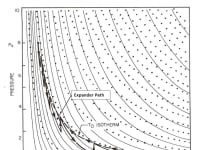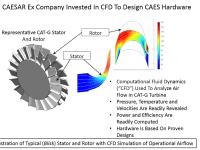This 'Expander' enables a major improvement in Compressed Air Energy Systems ("CAES") used for storage and recovery of Grid-Scale energy. It eliminates the present burning of fuel during energy recovery. Instead, it relies on thermodynamic principles to transform heat (from the air compression ) stored at ~85C into >10MW electrical power. The expander (called a CAT-G) sends high-pressure air into conventional turbine blades, connected to electrical generators which each extract ~2.5MW, causing the outlet air to be cooled to ~35C. A commercial heat-exchanger is attached to the air outlet, and heat is moved from the stored (and recycled) warm water to reheat the air to its initial temperature. In principle, energy has been borrowed from the air to drive the generator, then heat is taken from the warm water to replenish this energy. The outlet air, rewarmed and still high pressure, is then fed into a 2nd axially-connected turbine of slightly larger diameter (because the air has expanded) where another 2.5MW is extracted in the same manner.
By starting with stored air pressure ~26 bar, and utilizing 5 such sets of axially-connected and easily-scaled turbine rotors (w/ heat-exchangers), the air is expanded in stages to 1 bar; thereby producing ~12.5MW mechanical power(~10MWE, electrical), with energy recovery efficiency of ~90%.
"Wait!"
"How can you do that?"
"No one else even comes close to that efficiency!"
The pressure vs. volume plot in Fig. 1 overlays our thermodynamic expansion process and an ideal isothermal process having the same end points. Thus, by combining adiabatic expansions having small pressure drops with reheating steps (i.e., the vertical segments), we track the 'isotherm' very closely.
---Everybody knows that the isotherm represents 'the ideal'; a 100% efficient 'reversible' process!---
---We are so close; but, we could come even closer to 100% efficiency IF we used more stages.---
This is therefore both a design, and a design system.
"Wow!"
"But, can you make actual hardware produce the thermodynamic properties that you depict?"
---Let's get COMSOL Multiphysics running and simulate the critical aerodynamics.---
Our team used the CFD capability to analyze the flow and power parameters for a variety of known and measured turbine blades. Simulations were benchmarked against published data, and the temperature adjusted to examine performance w/ and w/o fuel burning. Simulation results (including turbulence) agreed closely with measured values and recovery efficiency was within a few percent of thermodynamic predictions.
Air (and water) flow rates and other aerodynamic effects of ducting were also simulated, establishing feasibility.
Displayed in Fig. 2, CFD simulation proves to be vital for complex aerodynamic design as we could examine profiles (e.g., pressures, velocities and temperatures) that are difficult and extremely slow and costly to measure.
Manufacturing is straight-forward with turbine cost promising to be even lower than for gas turbines because of low operating temperatures.
The Market: When combined with existing air-pump and compressed air storage capabilities, this expander design will constitute an efficient Air Battery that Power Utilities need to better manage the adding of renewable energy to the Grid.
Like this entry?
-
About the Entrant
- Name:Henry Gerard
- Type of entry:teamTeam members:Henry Gerard, Stephen Gerard, Kurt Lund, Steve Lord
- Software used for this entry:COMSOL Multiphysics
- Patent status:patented





